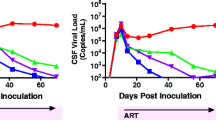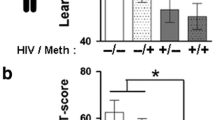Abstract
Humans and chimpanzees are the natural hosts for HIV. Non-human primate models of SIV/SHIV infection in rhesus, cynomologus and pigtail macaques have been used extensively as excellent model systems for pathogenesis and vaccine studies. However, owing to the variability of disease progression in infected macaques, a phenomenon identical to humans, coupled with their prohibitive costs, there exists a critical need for the development of small-animal models in which to study the untoward effects of HIV-1 infection. Owing to the fact that rodents are not the natural permissive hosts for lentiviral infection, development of small animal models for studying virus infection has used strategies that circumvent the steps of viral entry and infection. Such strategies involve overexpression of toxic viral proteins, SCID mice engrafted with the human PBLs or macrophages, and EcoHIV chimeric virus wherein the gp120 of HIV-1 was replaced with the gp80 of the ecotropic murine leukemia virus. Additional strategy that is often used by investigators to study the toxic effect of viral proteins involves direct stereotactic injection of the viral protein(s) into specific brain regions. The present report is a compilation of the applications of direct administration of Tat into the striatum to mimic the effects of the viral neurotoxin in the CNS. Added advantage of this model is that it is also amenable to repeated intraperitoneal cocaine injections, thereby allowing the study of the additive/synergistic effects of both the viral protein and cocaine. Such a model system recapitulates aspects of HAND in the context of drug abuse.





Similar content being viewed by others
References
Aksenov MY, Hasselrot U, Bansal AK, Wu G, Nath A, Anderson C, Mactutus CF, Booze RM (2001) Oxidative damage induced by the injection of HIV-1 Tat protein in the rat striatum. Neurosci Lett 305:5–8
Anthony JC, Vlahov D, Nelson KE, Cohn S, Astemborski J, Solomon L (1991) New evidence on intravenous cocaine use and the risk of infection with human immunodeficiency virus type 1. Am J Epidemiol 134:1175–1189
Bagasra O, Pomerantz RJ (1993) Human immunodeficiency virus type 1 replication in peripheral blood mononuclear cells in the presence of cocaine. J Infect Dis 168:1157–1164
Baldwin GC, Tashkin DP, Buckley DM, Park AN, Dubinett SM, Roth MD (1997) Marijuana and cocaine impair alveolar macrophage function and cytokine production. Am J Respir Crit Care Med 156:1606–1613
Baldwin GC, Roth MD, Tashkin DP (1998) Acute and chronic effects of cocaine on the immune system and the possible link to AIDS. J Neuroimmunol 83:133–138
Bansal AK, Mactutus CF, Nath A, Maragos W, Hauser KF, Booze RM (2000) Neurotoxicity of HIV-1 proteins gp120 and Tat in the rat striatum. Brain Res 879:42–49
Cayrol R, Wosik K, Berard JL, Dodelet-Devillers A, Ifergan I, Kebir H, Haqqani AS, Kreymborg K, Krug S, Moumdjian R, Bouthillier A, Becher B, Arbour N, David S, Stanimirovic D, Prat A (2008) Activated leukocyte cell adhesion molecule promotes leukocyte trafficking into the central nervous system. Nat Immunol 9:137–145
Chaisson RE, Bacchetti P, Osmond D, Brodie B, Sande MA, Moss AR (1989) Cocaine use and HIV infection in intravenous drug users in San Francisco. JAMA 261:561–565
Chen L, Swartz KR, Toborek M (2009) Vessel microport technique for applications in cerebrovascular research. J Neurosci Res 87:1718–1727
Chiasson MA, Stoneburner RL, Hildebrandt DS, Ewing WE, Telzak EE, Jaffe HW (1991) Heterosexual transmission of HIV-1 associated with the use of smokable freebase cocaine (crack). AIDS 5:1121–1126
Doherty MC, Garfein RS, Monterroso E, Brown D, Vlahov D (2000) Correlates of HIV infection among young adult short-term injection drug users. AIDS 14:717–726
Eisenstein TK, Hilburger ME (1998) Opioid modulation of immune responses: effects on phagocyte and lymphoid cell populations. J Neuroimmunol 83:36–44
Eugenin EA, Osiecki K, Lopez L, Goldstein H, Calderon TM, Berman JW (2006) CCL2/monocyte chemoattractant protein-1 mediates enhanced transmigration of human immunodeficiency virus (HIV)-infected leukocytes across the blood-brain barrier: a potential mechanism of HIV-CNS invasion and NeuroAIDS. J Neurosci 26:1098–1106
Fiala M, Gan XH, Zhang L, House SD, Newton T, Graves MC, Shapshak P, Stins M, Kim KS, Witte M, Chang SL (1998) Cocaine enhances monocyte migration across the blood–brain barrier. Cocaine’s connection to AIDS dementia and vasculitis? Adv Exp Med Biol 437:199–205
Friedman H, Newton C, Klein TW (2003) Microbial infections, immunomodulation, and drugs of abuse. Clin Microbiol Rev 16:209–219
Hayman M, Arbuthnott G, Harkiss G, Brace H, Filippi P, Philippon V, Thomson D, Vigne R, Wright A (1993) Neurotoxicity of peptide analogues of the transactivating protein tat from Maedi-Visna virus and human immunodeficiency virus. Neuroscience 53:1–6
Huang W, Rha GB, Chen L, Seelbach MJ, Zhang B, Andras IE, Bruemmer D, Hennig B, Toborek M (2010) Inhibition of telomerase activity alters tight junction protein expression and induces transendothelial migration of HIV-1-infected cells. Am J Physiol Heart Circ Physiol 298:H1136–H1145
Itoh K, Mehraein P, Weis S (2000) Neuronal damage of the substantia nigra in HIV-1 infected brains. Acta Neuropathol 99:376–384
Jones M, Olafson K, Del Bigio MR, Peeling J, Nath A (1998) Intraventricular injection of human immunodeficiency virus type 1 (HIV-1) tat protein causes inflammation, gliosis, apoptosis, and ventricular enlargement. J Neuropathol Exp Neurol 57:563–570
Kim BO, Liu Y, Ruan Y, Xu ZC, Schantz L, He JJ (2003) Neuropathologies in transgenic mice expressing human immunodeficiency virus type 1 Tat protein under the regulation of the astrocyte-specific glial fibrillary acidic protein promoter and doxycycline. Am J Pathol 162:1693–1707
Klein TW, Matsui K, Newton CA, Young J, Widen RE, Friedman H (1993) Cocaine suppresses proliferation of phytohemagglutinin-activated human peripheral blood T-cells. Int J Immunopharma 15:77–86
Larrat EP, Zierler S (1993) Entangled epidemics: cocaine use and HIV disease. J Psychoactive Drugs 25:207–221
Mao JT, Huang M, Wang J, Sharma S, Tashkin DP, Dubinett SM (1996) Cocaine down-regulates IL-2-induced peripheral blood lymphocyte IL-8 and IFN-gamma production. Cell Immunol 172:217–223
Meucci O, Fatatis A, Simen AA, Bushell TJ, Gray PW, Miller RJ (1998) Chemokines regulate hippocampal neuronal signaling and gp120 neurotoxicity. Proc Natl Acad Sci U S A 95:14500–14505
Meucci O, Fatatis A, Simen AA, Miller RJ (2000) Expression of CX3CR1 chemokine receptors on neurons and their role in neuronal survival. Proc Natl Acad Sci U S A 97:8075–8080
Nair MPN, Mahajan S, Hou J, Sweet AM, Schwartz SA (2000) The stress hormone, cortisol, synergizes with HIV-1 gp-120 to induce apoptosis of normal human peripheral blood mononuclear cells. Cell Mol Biol 46:1227–1238, Noisy-le-grand
Persidsky Y, Limoges J, McComb R, Bock P, Baldwin T, Tyor W, Patil A, Nottet HS, Epstein L, Gelbard H, Flanagan E, Reinhard J, Pirruccello SJ, Gendelman HE (1996) Human immunodeficiency virus encephalitis in SCID mice. Am J Pathol 149:1027–1053
Persidsky Y, Gendelman HE (2002) Murine models for human immunodeficiency virus type1-associated dementia: the development of new treatment testing paradigms. J Neurovirol 8 Suppl 2:49–52
Peterson PK, Sharp BM, Gekker G, Portoghese PS, Sannerud K, Balfour HH (1990) Morphine promotes the growth of HIV-1 in human peripheral blood mononuclear cell cocultures. AIDS 4:869–873
Philippon V, Vellutini C, Gambarelli D, Harkiss G, Arbuthnott G, Metzger D, Roubin R, Filippi P (1994) The basic domain of the lentiviral Tat protein is responsible for damages in mouse brain: involvement of cytokines. Virology 205:519–529
Reid W et al. (2001) An HIV-1 transgenic rat that develops HIV-related pathology and immunologic dysfunction. Proc Natl Acad Sci U S A 98:9271–9276
Roth MD, Tashkin DP, Choi R, Jamieson BD, Zack JA, Baldwin GC (2002) Cocaine enhances human immunodeficiency virus replication in a model of severe combined immunodeficient mice implanted with human peripheral blood leukocytes. J Infect Dis 185:701–705
Schilling M, Strecker JK, Ringelstein EB, Kiefer R, Schabitz WR (2009) Turn-over of meningeal and perivascular macrophages in the brain of MCP-1-, CCR-2- or double knockout mice. Exp Neurol 219:583–585
Steele AD, Henderson EE, Rogers TJ (2003) Mu-opioid modulation of HIV-1 coreceptor expression and HIV-1 replication. Virology 309:99–107
Tyor WR, Power C, Gendelman HE, Markham RB (1993) A model of human immunodeficiency virus encephalitis in scid mice. Proc Natl Acad Sci U S A 90:8658-8662
Vigorito M, LaShomb AL, Chang SL (2007) Spatial learning and memory in HIV-1 transgenic rats. J Neuroimmune Pharmacol 2:319–328
Webber MP, Schoenbaum EE, Gourevitch MN, Buono D, Klein RS (1999) A prospective study of HIV disease progression in female and male drug users. AIDS 13:257–262
Acknowledgments
This work was supported by grants MH-068212, DA020392, DA023397 and DA024442 (SB) and DA030285 (HY) from the National Institutes of Health.
Conflicts of Interest
The authors indicate no potential conflicts of interest.
Author information
Authors and Affiliations
Corresponding author
Rights and permissions
About this article
Cite this article
Yao, H., Buch, S. Rodent Models of HAND and Drug Abuse: Exogenous Administration of Viral Protein(s) and Cocaine. J Neuroimmune Pharmacol 7, 341–351 (2012). https://doi.org/10.1007/s11481-012-9355-2
Received:
Accepted:
Published:
Issue Date:
DOI: https://doi.org/10.1007/s11481-012-9355-2




